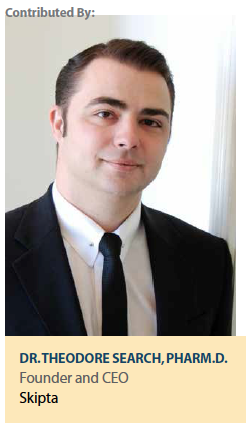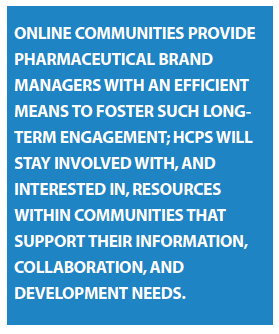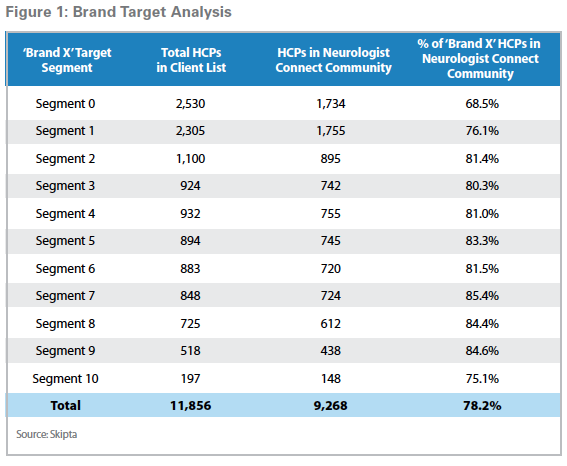 Thanks to the interactive capabilities of social media, pharmaceutical product promotion has advanced from talking to an audience to engaging with your audience. And with this evolution, the challenge for brand managers is no longer simply to know your audience, but to know what your audience finds valuable.
Thanks to the interactive capabilities of social media, pharmaceutical product promotion has advanced from talking to an audience to engaging with your audience. And with this evolution, the challenge for brand managers is no longer simply to know your audience, but to know what your audience finds valuable.
Consequently, researchers seek progressive channels to discern the views, concerns, and preferences of target audiences. One proven and increasingly popular strategy is to leverage the power of online communities to both survey and listen to healthcare providers (HCPs). A number of e-forums now make that possible in real time and much more cost-effectively than through traditional primary market research methods.
However, not all online communities are of equal value when it comes to gathering insights on what HCPs really want and need. Essentially, the more narrowly focused the makeup of the community, the richer members’ conversations, and the more useful the insights extracted. This deeper understanding paves the way for marketers to provide content and programs that members welcome and actively take part in. Such strong engagement ultimately leads to improved performance and better outcomes for patients.
The Power of Niche Communities
The best online forums — both for HCPs and the marketers who wish to reach them — are communities built around a common theme and that are restricted to participants whose qualifications have been verified. Ideally, community members share their identity with one another so that they develop a rapport, readily collaborating and sharing views and information. For HCPs, such communities provide opportunities to learn from, and work with, trusted sources in order to improve patient care. For brand managers, the forums are an efficient way to reach targeted HCPs with powerful messaging and engaging programs that develop relationships and stimulate behavior change.
Such specialized communities mimic the real world of healthcare and medical practice. Imagine, for a moment, a stadium filled with HCPs. Given enough time, we theorize that the providers would naturally begin to congregate into subgroups by professional focus — rheumatologists in one corner, certified nurse anesthetists in another, medical directors in another, and so forth.
 Now, imagine the difference in the type of conversations taking place before versus after the division into homogenous groups. One would be a cacophony of chatter on general topics; the other would be deep and meaningful exchanges on very specific subjects related to either the profession or disease area of shared interest. An immunologist and a plastic surgeon, for example, would be more likely to discuss the weather than to compare notes on immune checkpoint inhibitors (ICI), whereas a group of immunologists might eagerly talk about very detailed facets of their ICI prescribing decisions and comparing treatment challenges.
Now, imagine the difference in the type of conversations taking place before versus after the division into homogenous groups. One would be a cacophony of chatter on general topics; the other would be deep and meaningful exchanges on very specific subjects related to either the profession or disease area of shared interest. An immunologist and a plastic surgeon, for example, would be more likely to discuss the weather than to compare notes on immune checkpoint inhibitors (ICI), whereas a group of immunologists might eagerly talk about very detailed facets of their ICI prescribing decisions and comparing treatment challenges.
Three Means of Gathering Insight
Brand managers wishing to do their homework prior to developing a program to educate and engage their audience can draw upon niche communities of HCPs in three different ways, each of which has its place. The research options are to:
1. Survey a targeted list of HCPs within a community to collect both quantitative and qualitative insights.
2. Listen in on vibrant, digital conversations among community members, performing analyses based on specific key words.
3. Prompt a discussion among a very select group of key opinion leaders (KOLs) in a by-invitation-only virtual meeting and gather their perspectives over a specific time period. When a small set of KOLs are given such an opportunity, they relish the ability to confer and debate. They tend to feed off of one another’s ideas and opinions, sparking a very deep and relevant discourse. The subsequent analysis provides robust insight into the participants’ mindsets and needs, supporting the brand’s research objectives.
Which community-based research methodology is most effective in any given situation, or the order in which these approaches should be deployed depends upon the brand strategy. With all three options, the HCPs are digitally engaged and inclined to participate because they’ve already found value in their community membership. Plus, most important, the communities are built around a narrow, shared topic of interest, so the questions asked and discussions generated are not watered down or generalized; they are potent and germane to very specific lines of inquiry.
Applied Research: A Real-Life Example
One pharmaceutical company launching a treatment for neuropathic pain tapped a closed-loop online community created for more than 13,000 neurologists. The company used the community to deliver a multi-faceted, year-long campaign that was highly engaging and demonstrated an increase in prescribing behavior.
 Before developing messaging and designing the campaign, the company gleaned a wealth of information from a digital steering committee of 15 of the most renowned neurologists in the United States. These select KOLs were invited to join a virtual meeting for a week, where discussion prompts were posted according to the company’s learning objectives. The ongoing conversation was mediated and monitored.
Before developing messaging and designing the campaign, the company gleaned a wealth of information from a digital steering committee of 15 of the most renowned neurologists in the United States. These select KOLs were invited to join a virtual meeting for a week, where discussion prompts were posted according to the company’s learning objectives. The ongoing conversation was mediated and monitored.
The resulting exchanges gave the company a detailed understanding of what issues were on the KOL’s minds, what facts on neuropathic pain they were missing, and what information would help them make informed decisions that could benefit their patients.
Based on the resulting analysis of what the audience would most value, the company ran a comprehensive engagement campaign consisting of a sponsored a group page for neurologist community members to disseminate product/disease state information, unbranded banner ads, and branded informational alerts and e-newsletters over the course of a year. Nearly 78% of the company’s neurologist target were registered members of the community. (See Figure 1.)
The campaign supported ongoing engagement among neurologists, giving the company a means to develop lasting relationships with prescribers. The longitudinal nature of the campaign allowed the company to monitor the success of various aspects and to refine the program as it progressed. Indeed, the level of engagement grew steadily. In the second six months of the campaign, viewership increased by 75%.
The impact of the program was measured by comparing prescribing patterns of neurologists participating in the community and exposed to the campaign with a matched control group of neurologists that were not in the community. The brand saw a significant increase in new prescriptions between the test and control groups, and because the product treats a chronic condition, the company could expect a dramatic upturn in total prescriptions over time.
The return on investment (ROI) analysis revealed that in new prescription terms, the campaign generated and ROI of 7.6: 1 and in total prescription terms, an ROI of 24.6: 1 (based on a 12-month prescribing period).
Building a Loyal Community
Forbes magazine defines relationship marketing as “a strategy designed to foster customer loyalty, interaction and long-term engagement. It is designed to develop strong connections with customers by providing them with information directly suited to their needs and interests and by promoting open communication."
Online communities provide pharmaceutical brand managers with an efficient means to foster such long-term engagement; HCPs will stay involved with, and interested in, resources within communities that support their information, collaboration, and development needs.
Obviously, a critical step in the engagement process is, therefore, to understand for a given audience, what information is “directly suited to their needs and interests." This understanding can be gained from online communities via various means (surveys, passive listening, and moderated discussion boards). However, for the feedback to be highly relevant, the community must be narrowly defined, with members aligned by professional focus and treatment interests. When this is the case, brand managers can formulate strategies and messages that not only resonate, but also deliver value. This approach is a win/win for the brand and for providers and their
patients. (PV)
Skipta is the leading social network of specialized online medical communities for verified healthcare professionals.
For more information, visit skipta.com


















